

202 BC
The decisive victory of Scipio on Hannibal closed the Second Punic War and giving to Rome, once for all, the supremacy in the Mediterranean.
ZAMA
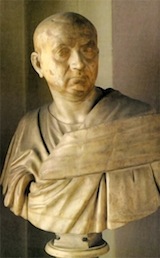
Scipio was one of the greatest Roman general and statesman. In 211 BC, just 24 years old, was sent to Spain by the Senate as proconsul to regain control of Iberia; in 209 BC, he led a successful surprising attack against the headquarters of the Carthaginian army stationed at Carthago Nova (modern Cartagena); the following year he defeated the Carthaginian General Hasdrubal, failing, however, to prevent him from crossing the Pyrenees and reaching Italy for aiding his brother Hannibal. He managed to conquer Cadiz chasing out permanently, from Spain, the Carthaginian army.
Elected Consul in 205 BC, between 204 and 203 BC led a military campaign in North Africa, defeating the Carthaginians at Bagbrades (present-day Souk al-Khamis, in Tunisia). Hannibal was recalled back from Italy and Scipio pursued him until the decisive victory at the battle of Zama (202 BC). For this victory, which ended the Second Punic War, Scipio was nicknamed "African".
In 190 BC, during the consulship of Lucius Cornelius, was his advisor in war against the Seleucid King Antiochus III, which ended with the defeat of the Syrian army at Magnesia, in Asia minor. Back in Rome, Scipio was accused by his political opponent Marcus Porcius Cato have accepted money from Antiochus and underwent a process.
Acquitted of the charges, he retired from public life in his Literno's villa, in Campania, Italy.
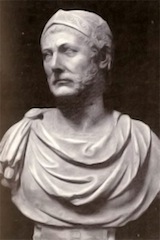
Considered as one of the greatest strategist in history, became famous for his victories in the Second Punic War. Son of Hamilcar Barca, who had inculcated hatred against Roma in him, was born probably in 247 BC. At 25 years, succeeded his brother-in-law Hasdrubal in the government of Spanish territories and after two years, he completed the conquest of Iberia with the successful siege of Saguntum (which fell in 219 BC), city allied with Rome, starting the Second Punic War against the "Urbe", nicknamed "war against Hannibal", since he was the undisputed protagonist.
From Spain, he crossed with his Army the Pyrenees and the Alps, then, in Italy, he defeated the Roman legions at Ticino (218 BC), at the Trebia (218 BC), at Lake Trasimene (217 BC) and Cannae (216 BC). After Scipio's victory in Tunisia was recalled to Africa in 204 BC to defend Carthage and was subsequently defeated by the same Scipio at Zama in 202 BC.
After the final defeat of Zama was exiled in Syria by the Seleucid King Antiochus III in 195 BC and later, after the defeat of Antiochus III by the Romans, in Bithynia at the King Prusias I in 189 BC. Here he ends his life by poisoning himself in 183 BC, in order not to fall into the hands of the Romans.
ZAMA
With the battle of Zama in 202 BC, fought in a plain about 100 miles southwest of Tunis, Rome had ended the Second Punic War with a decisive and definitive victory that sanctioned the end of Carthaginian power.
During the Second Punic War, the Roman Republic and the Roman army underwent many changes. The disaster of Cannae, with annihilation by Hannibal of the eight legions commanded by Lucius Aemilius Paullus and Gaius Terentius Varro seemed to have scored a decisive point in favour of Carthage in the long struggle with Rome. But it wasn't; the delaying strategy of Fabius Maximus managed to raise the fortunes, infact Rome had great organizational and military resources. The Senate immediately ordered the reorganization of the army. Hannibal meanwhile, disappointed by the failure to let defect, from the Roman camp, most of the Italic allies of the Republic, had to settle for a demonstration in force before the walls of Rome but then, without adequate siege engines, was forced to return in southern Italy hoping to consolidate its positions. Just keeping its eyes on the movements of the great Carthaginian in southern Italy, Rome, who, in 212 BC already had 22 legions, more than they had before Cannae, devoted itself to hit Carthaginian interests where they were most vulnerable.
The interests of the Republic, during the war, had moved. This interests were no longer those who had seen strating hostilities between the two cities for hegemony in Sicily. That policy, limited to the control of the Italian peninsula, starting from a solid presence in Lazio and in Central Italy, was changed into a full-fledged power politics, with the Mediterranean as a centre, Iberia as an addictional theatre and soon the Near East of the Hellenistic kingdoms as a goal.
The Roman ruling class itself was deeply changed during the course of wars. This class does not tolerate the limitations imposed at home by themos maiorum, the costumes of the fathers, and, together with the political cosmopolitanism of Hellenistic-style, it aspired to a richer lifestyle, more elegant, and far more representative of what would have been the new expansive phase of the Republic.
The army was significantly changed. What Publius Cornelius Scipio led to victory at Zama in 202 BC, was only superficially similar to the army that Hannibal had roundly defeated at Cannae in 216, although many of the men were veterans of that defeat. Organisational structures remained the same: the manipula, derived from the reforms of Camillus, more than a century before, still divided the Legion into three lines of hastati, principes and triarii, but the soldiers that composed it were no longer the same. The army defeated at Cannae was composed of citizens with the nerve of smallholders of Roman citizenship, certainly brave and accustomed to the hardships of the war, but only for a single campaign, linked as they were to the farm left in the "agro romano" and disinclined to remain in the field for more than one or two years. The Scipio's army at Zama was real professional army, made up of well-trained volunteers and veterans hardened by years of campaigning that had made them real soldiers, loyal to their commander and willing to stay in the army for all his life.
Will men like these, linked to Rome and even more attached to their generals, that conquered for Rome the control over the entire Mediterranean area. Will men like these to overwhelm the power of the Greek phalanx, hitherto regarded as invincible. Finally, will be men very similar to those that, in the whirlwind of the civil wars, a century later, that will mark the end of the ancient Republic turning it first in the Principality, then in the Empire.
Some historians argue, and probably with good reason, that Rome, the Imperial Rome, would not have been the same if he hadn't to struggle against Carthage. We can perhaps say that the seed containing the shape and ideology of Imperial Rome was thrown in that year 202 BC, at Zama.
ZAMA
In 211 BC, the Senate took an important decision, which will decide the birth of Roman imperialism. A commander of just 24 years old but already very experienced, considering his 7 years of military service, was sent to Spain as proconsul: that was the first important mission for Publius Cornelius Scipio. The young Roman leader began a merciless war against Carthaginian settlements with numerous victories, conquered the Carthaginian army headquarters at Carthago Nova (modern Cartagena) in 209 and, with the victory of Baecula, defeated Hasdrubal in 208 whose mission was to lead an army in Italy as aid to his brother Hannibal. In 207 Hasdrubal was however able to cross the Pyrenees and come in Italy, but was severely beaten on the Metauro River, in the Marche region of Italy. Hannibal had certainly need reinforcements, but definitely to overturn the outcome of the conflict had especially need of a general skilled and experienceed as was his brother. The head of his brother, that the Romans launched in the Carthaginian camp, was a clear sign to Hannibal that the hopes to receive support from motherland had disappeared forever. The only allied and the only base that remained to Hannibal were in the rugged mountains of Bruzio, reduced its range to avoid any clash with the Romans.
Hasdrubal Gisco and Mago Barca, in 206, reiterated the offensive against the Roman presence in Spain but, at the battle of Ilipia, Scipio overcame Hasdrubal Gisco, ending definitely the Carthaginian domination in Spain by chasing out, in fact, the armies of Carthage from the Iberian Peninsula.
Returning to Rome in 205 Scipio was nominated Consul and from this position he tried to convince the Senate to support him in his project: bringing the war in Africa as to finally defeat Carthage. The Senators knew he could beat Carthage but not considered necessary an immediate intervention because, at the time, Rome was not in dangerous conditions, and the presence of Hannibal in Italy could not continue indefinitely, considering the strategic and economic marginality of the Carthaginian possession. Fabius Maximus, supported by a large part of the Senate as a supporter of peace, considered Scipio's proposal as an enterprise with uncertain and useless risks, especially because the threat of Hannibal could come back. However according to Scipione, Hannibal was not longer a threat. He had led the Roman legions in the conquest of Iberian territories beating overnumbering enemies and was convinced he could beat Hannibal on its territory marking the end of Carthage and giving to Rome the supremacy in the Mediterranean. Supported by the people, Scipio convinced the senators, was appointed as a consular province Sicily, with permission to leave for Africa, but he wasn't allowed to recruit new legions, could enlist only volunteers and received the command of the V and VI Legion in Sicily, composed of the veterans of Cannae to which had added the defeated soldiers of the two battles of Herdonea. Scipio confided in the value of those veterans and believed in their eager to avenge the shame of defeat, arrived in Sicily with 7,000 volunteers. Soon after his first "contact" with the troops, began the training for the soldiers that he consider of primary importance. He wouldn't leave until his men had assimilated his tactical schemes that formed the basis of all his victories.
In 204 Scipio sailed from Lilybaeum (Marsala) with 16,000 infantry and 1,500 Cavalry; he transformed a group of volunteers and Veterans exiled in a perfect war machine, the more efficient than Rome had ever seen. He landed near Utica (porto Farina) and besiege it. His legions were reinforced by Numidian Cavalry of Prince Massinissa, skillful Knights, once allied with the Carthaginians, now exiled by King of the numidians Syphax, who had chosen the alliance with Rome offering to Scipio his own friendship and his services.
Meanwhile, the Carthaginians had rise a large army of 30,000 infantry and 3,000 Cavalry led by Hasdrubal and Syphax, King of the numidians, an ally of Carthage, was coming with an army of 60,000 men including 10,000 cavalry. The two enemy armies deployed at dozen kilometres south from the Roman camp. After a series of ups and downs and peace negotiations, in 203 Scipio attacked the numidians and Punic camps with a great victory. According to the sources, Punic causalties were 40,000, with few soldiers escaped, such as Syphax and Hasdrubal, while Roman casualties were part of the order of tens. This victory, immediately followed by another one at Bagbrades (near the present-day site of Suk Al-Khamis, in Tunisia), where he routed the army gleaned in hurry by Carthage, led once again by Hasdrubal and Syphax. Achieved these successes, Publius Cornelius Scipio camped nearby Tunis, so to threaten Carthage which, however, with its mighty walls, always remained a bastion difficult to capture.
Threatened directly on African soil and in a panic, the Grand Council of Carthage there was nothing left to do than call back home Hannibal and his army; that was what Scipio wanted. He knew that the challenge with Hannibal should be permanently closed and on African soil. Confident, as he was, to command the best troops in the world, he could defeat Hannibal only once drawn the Carthaginian into a pitched battle.
The Romans granted a truce, a truce that let Hannibal, with part of his veterans, to abandon Italy after 15 years as to return to Carthage, camping at Hadrumentum (Sousse), within his family's possessions.
Refreshed by the return of their leader, the Carthaginians, unknowingly, completed the plan of Scipio: once rejected the truce, Hannibal moved verus the Romans a numerically strong army, but, if we exclude the 15,000 veterans he had brought from Italy, inferior than the Scipio's Legions. The Romans, confident in their quality and in the ability of their Commander, met the enemy at Naraggara (Sidi Youssef), a plain about 15 kilometers from Zama.
ZAMA
The Roman Legion was generally deployed in "checkerboard" order on three rows of combat divided in manipula. The front row was formed by the hastati units, separated by a space equal to that occupied by a single manipula; the gaps were covered by maniples of principes, which occupied the second row; the last row was formed by triarii covering the ranges left empty by the manipula of principes.
The hastati and principes formed the backbone of the Roman Legion, they were enlisted among men in full force. Their functions were identical but, as mentioned, were arranged differently in the grid: the hastati in front row and the principes in the second. They were equipped with a bronze helmet, armour and a large oval shield. The armament consisted of two javelins of different weight called pila (singular pilum) and a short sword that challenged in hand-to-hand combat after having thrown the javelins.
The light infantry was formed by the velites, formed by younger soldiers assigned as support to each maniple. They wore a helmet of bronze, often covered by a wolf skin, a round shield called parma, some light javelins and a short sword in Italian or Spanish style similar to that of heavy infantry. The older Legionnaires formed the triarii manipula and, in battle, they were placed in the third row of the Legion. Fitted with equipment identical to that of principes and hastati, were armed instead of pilum by a long spear of greek hoplitic origin. The triarii could be used tactically as a mobile reserve behind the Legion, or as support to repel with their long rods the attacks of enemies cavalries. On some occasions the triarii were fighting on the flanks or on the rear of the opposing formations, already engaged on the front from the first two rows.
The Carthaginian army was formed by mercenaries recruited among the populations subject to the Carthaginian domain. So we can consider this as an army made up of different people with different military traditions. During the Second Punic War the main recruiting areas were: the African hinterland, from which came the famous numidian light cavalry, one of the best weapons in Hannibal's army and the heavy libo-Phoenician infantry; and the Iberian colonial Territories, which provided the Carthaginian armies of a fierce light-medium infantry and cavalry.
Moreover, in Hannibal's victories in Italy did attended, among the Carthaginian forces, the Gauls of the Po Valley and many Italians of the South. During the campaign of Hannibal, his troops often riequipped themselves with the material captured by the Romans on the battlefield, these soldiers will be his "Veterans" at Zama.
ZAMA
Publius Cornelius Scipio could count on 23,000 infantrymen among the Romans and Italians plus 6,000 Numidians. The cavalry could count on 2,400 between Romans and Italians, 4,000 Numidians and 600 Berbers. The roman Cavalry superiority wasn't just numerical but even qualitatively, considering the numidians knights of Masinissa, who had often been decisive supporting Hannibal in Italy; and considering 300 Roman Knights, very well equipped and particularly trained by Scipio in Sicily.
Hannibal could count about 15,000 veterans of the italian campaign, especially italians or spaniards, 15,000 Lybian and Carthaginians infantrymen, recently taken by the Carthaginian Senate and of dubious usefulness, 12,000 mercenaries among Ligurians, Celts, Mauritanians plus 4,000 Macedonians. The cavalry had 2,000 carthaginians and 2,000 numidians. To these were added 80 African forest's elephants, smaller than those of the savannahs, but still dangerous.
ZAMA
The two armies deployed in a wide plain without impediments, ideal for a large pitched battle.
Hannibal lined up his army on three lines, keeping in mind the quality of his troops. In front of the army were deployed war elephants as to putting in disarray the first lines of the Roman infantry. At the forefront were deployed the various groups of mercenaries, Italic allies, Gauls and Ligurians; many of these were always overwhelmed by roman legionaries and had followed reluctantly the Carthaginian leader. Hannibal knew that, to these units, could ask only one initial impetus united to that of the elephants, certainly not an all-out resistance. The second row, at short distance from the first, was formed by African contingents hastily recruited from Carthage to confront the Roman invasion. Even these units weren't reliable, as they were without adequate training and experience, able to confront the Romans only after the intervention of elephants and mercenaries. In the third row, far beyond the first two lines (about 178 meters), Hannibal had deployed his veterans of italian campaign ready to intervene, even with more complex tactics, perhaps to strike the decisive blow. On the wings the Cavalry, on which Hannibal had not much expectations, thier task was just to neutralize and block the Roman cavalry, superior in numbers and training. Therefore a differentiated deployment of appropriately trained troops, elephants and mercenaries will form the first two strikes in succession, the African troops will provide support and a veteran reserve, had to confront the Roman when they had been eventually worn.
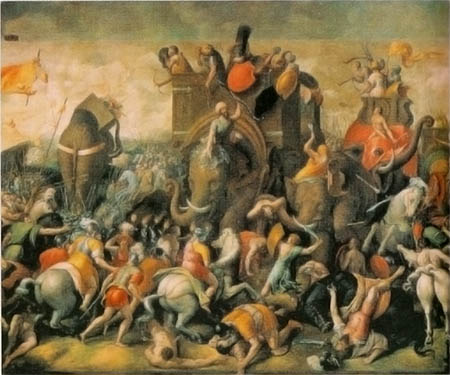
Even Scipio had deployed his forces on three lines, as usual. But, instead of alternating maniples in checkerboard formation, dispose the manipula in column as to create "lanes" to let pass the predictable elephant attack. Therefore at the forefront were deployed the hastati, with velites covering the "lanes" and acting as bait: they had to absorb the first impact with elephants, they had orders to move once the elephants were almost in contact with the infantry, leaving open the gates and allowing the pachyderms to slip in "aisles" to be targeted on the flanks. In the second line were placed the maniples of principes, while those of the triarii, according to tradition, were in third-line. The Roman cavalry of Caio Lelio was on the left, while on the right was the Numidian Masinissa's cavalry. Moreover, among the front rows Scipio disposed several men with trumpets and percussion instruments which had the task of making noise as to scare the elephants.
ZAMA
The battle, as Scipio predicted, was opened by the attack of the Carthaginian war elephants.
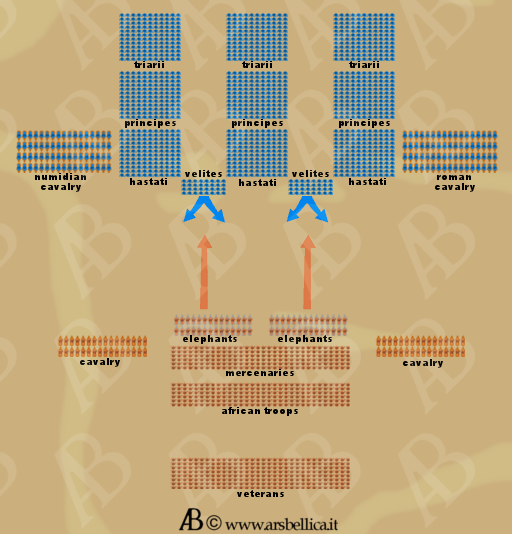
The pachyderms, however, appalled by the javelins launched by the velites and frightened by the sounds coming from the ranks of Rome, were partly driven back and slipping on the flanks of the Carthaginian infantry, went to cluttering up the wings of cavalry. Once saw the difficulty of the Carthaginian Cavalry wings, Caio Lelio and Masinissa attacked and, after a brief melee, both units of Hannibal's cavalry were routed, pursued by the roman knights. The other elephants had more success but were channeled into the spaces left by the manipula. The elephants passed without causing damages to hastati, principes and triarii, only the velites aid a hefty price, already considered by Scipio who got what he wanted: his line has been ordered, the hastati were intact and the principes were not involved.
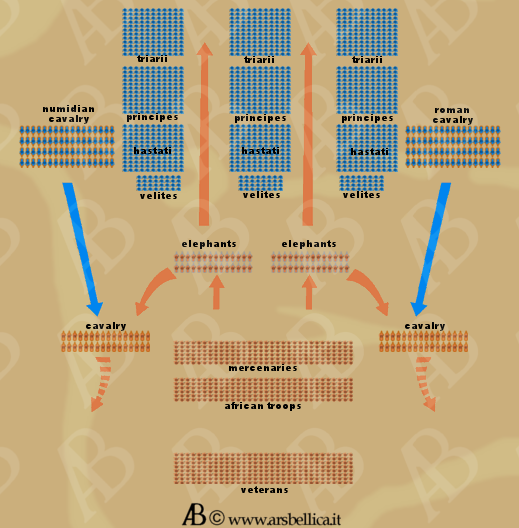
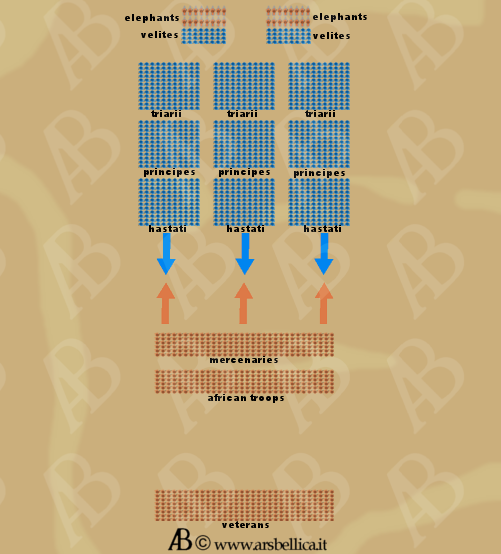
Thereupon, the infantry advanced and were in contact, except Carthaginians veterans who maintained the position. The battle was very violent and started a confused melee with large gaps that opened in the mercenaries formation where some fled. In addition, the line of African toops not intervened to support immediately, because the front was occupied by fugitives they prevented from going through as to not cluttering up the ranks. Sonna as they had the front enough free, some departments of African troops joined the fray, coming in contact with the hastati, who had left the position to pursuit the fugitives. It was necessary the support of principes in the points where the hastati had not recovered the position. In, this disorder, the Romans, better trained and armed, manage to prevail. The first two Carthaginians rows, now mixed, begin to abandon the combat line and some flee.
Hannibal was able to regain control of some African and mercenaries units and reorganize veterans sides, trying to widen the front as to surround the roman flank. Scipio, reorganized the hastati, already in pursuit of fugitives, let move his legionaries on the flanks, tactic already successfully used previously, but this time only to extend either side of the hastati's front but not to outflank the enemy. So the Roman front result equal to or slightly greater than the Carthaginian one, with principes and triarii, so far little committed, that had to fight on the wings against tired forces, although the hastati, committed so far in the clash, now had to contend with the Carthaginian veterans still fresh.
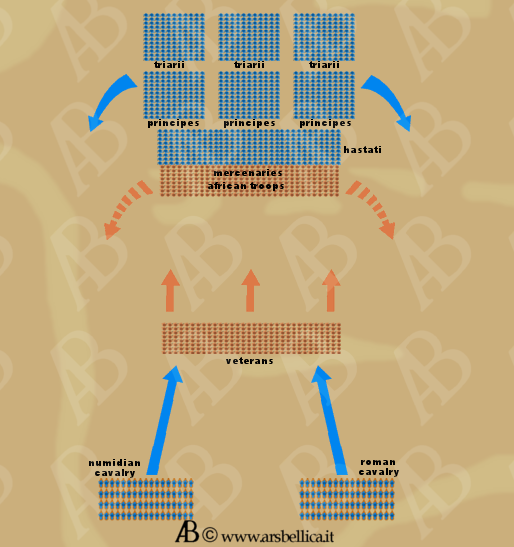
The fight between the infantry seemed to continue for a long time, with an uncertain outcome, but the Roman chivalries, who had now scattered the enemy Knights, returned to the battlefield attacking from behind Hannibal's troops. These, closely pressed by the Roman cavalry, quickly flee. As always happened in the wars of antiquity, once finished the battle, began the pursuit and the massacre. Hannibal managed to escape to Carthage but had left on the field at least 20,000 dead and 10,000 prisoners. Romans accounted losses to a maximum of 4,000 men, half of whom were numidians. Scipio had the pitched battle that he wanted and this victory had ended the second deadly conflict between Rome and Carthage.
ZAMA
The decisive victory at the battle of Zama ended the Second Punic War (219-202 BC) and was, in fact, the end of Carthaginian power in the Mediterranean. Carthage, the great city of Phoenician origin that, with his business empire, for sixty years had contested Rome in the dominance of the Western Mediterranean, was defeated. Rome forced the rival city-State to a humiliating peace. A heavy Treaty required to dismantle completely the war fleet, only a few dozen ships were allowed to the Carthaginian Navy; all Carthaginian colonies in Spain passed under Roman control. The same foreign policy of Carthage had to conform to the Romans and the Punic were forced to pay a heavy tribute which, for fifty years, burdened on its economy.
Half century later there would be a third Punic War, which culminated with the destruction of Carthage, but it was more a posthumous Roman revenge than a consequence of a resurrected Carthaginian power that, after Zama, was definitely set.
Fearing Roman vengeance the city forced Hannibal, his greatest son, into exile at Syria's King Antiochus III; after the defeat of the latter against the Romans in Bithynia, Hannibal was poisoned so as to not be hand over in Rome. The defeat of Carthage is the first element in the construction of the Roman hegemony that somehow still marks the civilisation of our continent.
Bibliography:
Tito Livio, Storia di Roma, Traduzione di Gian Domenico Mazzocato, Roma, Newton & Compton, 1997;
Tito Livio, Storia di Roma dalla sua fondazione, Milano, BUR Biblioteca Univ. Rizzoli, 1986;
Polibio, Storie, Traduzione di M. Mari, Milano, BUR Biblioteca Univ. Rizzoli, 1993;
Antonio Spinosa, La Grande Storia di Roma, Milano, Mondadori, 1998